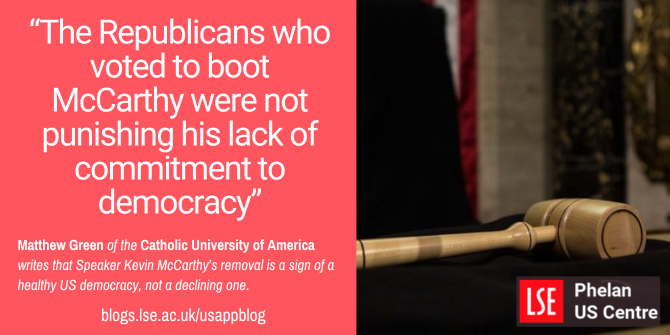 Earlier this month the US House of Representatives voted to oust the House Speaker, Republican Kevin McCarthy. Matthew Green writes that it is impressive that McCarthy lasted as long as he did, given the fractured nature of the GOP caucus and the recent pattern of Speaker instability. He argues that while McCarthy was removed by a House rule that conflicts with how the chamber operates in practice, his removal is also a sign that US democracy is working as it should.
Earlier this month the US House of Representatives voted to oust the House Speaker, Republican Kevin McCarthy. Matthew Green writes that it is impressive that McCarthy lasted as long as he did, given the fractured nature of the GOP caucus and the recent pattern of Speaker instability. He argues that while McCarthy was removed by a House rule that conflicts with how the chamber operates in practice, his removal is also a sign that US democracy is working as it should.
History was made on October 3 when the US House of Representatives voted for the first time ever to remove its top leader, Speaker of the House Kevin McCarthy (R-CA). Only eight Republicans voted for the resolution to declare the speakership vacant, but they were joined by every voting member of the minority party, and the resolution passed, 216 to 210.
Why did it happen, and what does it mean for the future of Congress? Here are four important takeaways from the historic vote to oust McCarthy as speaker.
It’s impressive that McCarthy lasted as long as he did
The 2022 midterm elections gave House Republicans an extremely small majority (222 seats out of 435), and the party included a sizeable, 40-plus member group of conservatives, the House Freedom Caucus, which was largely disdainful of bipartisan compromise and had a reputation for defying GOP leaders.
Given the challenging political context, it’s noteworthy not only that McCarthy was elected Speaker – a battle that took 15 rounds of balloting on the House floor in January – but that he wasn’t removed sooner. He even managed to pass a debt limit increase in June despite the vehement opposition of party conservatives.
McCarthy’s main strategy for survival, as one GOP staffer put it, was to “give everyone what they want.” The bulk of his concessions were to GOP conservatives, which kept most – but not all – Freedom Caucus members at bay. But McCarthy had to make some compromises with Democrats to get the debt limit bill and other must-pass measures enacted, and the Freedom Caucus could not maintain unanimity within its own ranks, let alone corral non-Caucus members who didn’t like McCarthy.
At the same time, McCarthy’s concessions to his right flank often damaged his relationship with Democrats, who cited a laundry list of examples in which McCarthy broke his word to them, blamed them for his own missteps, or tried to trap them into taking politically difficult votes. This proved extremely damaging to the Speaker, since he had to have their support (or at least not their opposition) if he hoped to survive the vote to vacate.
McCarthy was removed by a House rule that conflicts with how the chamber operates in practice.
The House mostly follows a party-driven model of decision-making: the majority party decides its nominee for Speaker, sets the legislative agenda, and tries to pass major legislation without relying on the minority party for votes.
What if the governing party suffers from internal divisions? In most cases, the party is able to persuade would-be dissidents to cooperate prior to any floor vote, even permitting some defections provided it doesn’t change the outcome. If that doesn’t work, the majority party uses its agenda-setting power to keep measures from coming to the floor that would divide it and give the minority a chance at victory.
But irreconcilable divisions over the selection of the Speaker cannot be dealt with that way, because the chamber’s rules allow just one dissident to force a vote to declare the speakership vacant. In other words, the removal procedure assumes the majority party acts as a unified cartel on the selection of Speaker. The GOP has not.
Interestingly, the vacancy procedure dates back to the 1910s, but — recognizing that it was incompatible with a majority-party driven House with internally divided parties — then-Speaker Nancy Pelosi had it changed so that only a majority of either party could bring the resolution to the floor directly. McCarthy undid that change in January to get more votes to be elected Speaker. As I warned in an op-ed last November, “if [McCarthy] is elected speaker but gives away the store in the process, it will be a Pyrrhic victory.”
The premature end of McCarthy’s speakership follows a long pattern of speaker instability.
The GOP’s tiny majority and internal divisions, coupled with the process for removing the Speaker, were the immediate causes of McCarthy’s ouster. But it was also the latest example of a long-term trend in congressional politics that has made the speakership a more vulnerable position for members of both parties.

“Located on the rostrum of the House Cham” (CC BY-NC 2.0) by SpeakerBoehner
As I noted in a LSE blog post from 2015, during the mid-20th century the speakership almost always was held until the occupant either died in office or chose not to run for reelection. But starting with Jim Wright (R-TX) in 1989, the House shifted to a “revolt and rejection” pattern in which speakers either quit prematurely or were forced out by voters or by their colleagues:
- Speakers Wright, Newt Gingrich (R-GA), and John Boehner (R-OH), under pressure from members of their own party, resigned from the speakership and from Congress.
- Dennis Hastert (R-IL) and Nancy Pelosi (D-CA) lost their speakerships when their majority disappeared (in 2006 for Hastert, in 2010 and 2022 for Pelosi).
- Tom Foley (D-WA) lost reelection in 1994.
- Only Paul Ryan (R-WI), who was chosen Speaker after Boehner, did not follow this pattern, as he retired at the end of his term.
McCarthy’s removal, though unprecedented, was a new twist on the same theme. So long as party control of the House remains closely competitive, and the GOP suffers from internal factions who are willing to undermine or even jettison their own leaders, this pattern will continue.
The removal of McCarthy is a sign of a healthy democracy, not a declining one.
Some scholars and journalists have claimed that McCarthy’s dismissal was a sign of democratic decay in the United States. “This is what [democracy in trouble] looks like,” warned Daniel Ziblatt, coauthor of the 2018 book How Democracies Die. Former defense secretary Robert Gates told the New York Times that “the events of the last couple of days have only underscored how real is the dysfunction.”
To be sure, the long vacancy in the speakership that followed McCarthy’s ouster effectively paralyzed the legislative branch. But a compelling argument can be made that the ouster of McCarthy demonstrated a strong democracy, not a weak one. After all, the Speaker was removed by a majority of elected representatives using an established procedure, which – however incompatible that procedure may be with party-based governance in the House – represents precisely the kind of decision-making that is the cornerstone of democracy.
In addition, McCarthy himself was hardly a defender of democratic rules and norms. On January 6, 2021, then-minority leader McCarthy voted to decertify the electoral college votes of two states that had voted for Joe Biden, and he refused to discourage other Republicans from doing the same. Mere weeks after Donald Trump supporters had launched a violent assault on the US Capitol hoping to keep Biden from taking office, McCarthy visited the former president in Florida, helping restore Trump’s standing in the party. Later, as Speaker, McCarthy endorsed a questionable effort to impeach Joe Biden with scant evidence of high crimes or misdemeanors, and he refused to follow common practice by letting the House vote first on whether to allow an impeachment investigation.
To be sure, the Republicans who voted to boot McCarthy were not punishing his lack of commitment to democracy. To the extent they wanted McCarthy out, it was because he dared to compromise with Democrats. And as of this writing, one of the strongest contenders for the speakership is Jim Jordan (R-OH), who was even more deeply involved in trying to undo the 2020 election. Nonetheless, while there are plenty of good reasons to worry about the fate of American democracy, as Yuval Levin and others have carefully documented, Congress using a majoritarian process to remove a speaker who placed power and party before democracy is not one of them.
- Please read our comments policy before commenting.
- Note: This article gives the views of the author, and not the position of USAPP – American Politics and Policy, nor the London School of Economics.
- Shortened URL for this post: https://bit.ly/3rWWAFd





